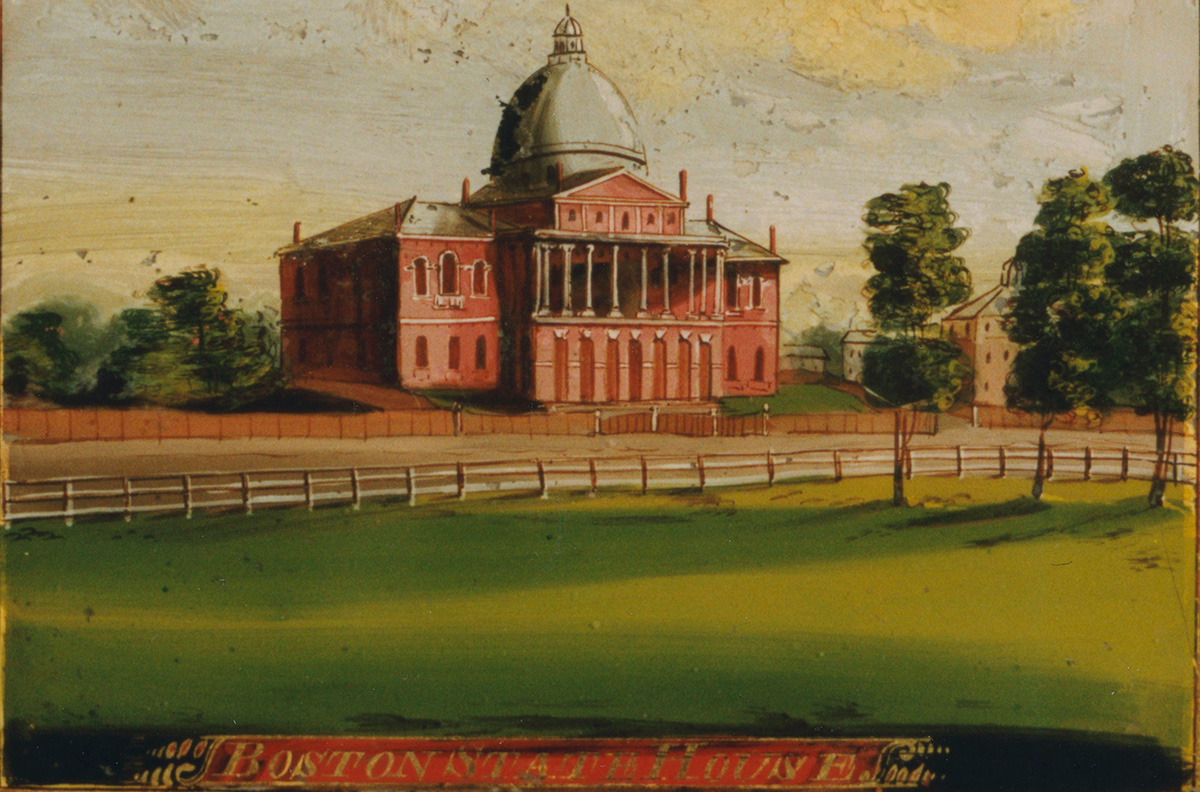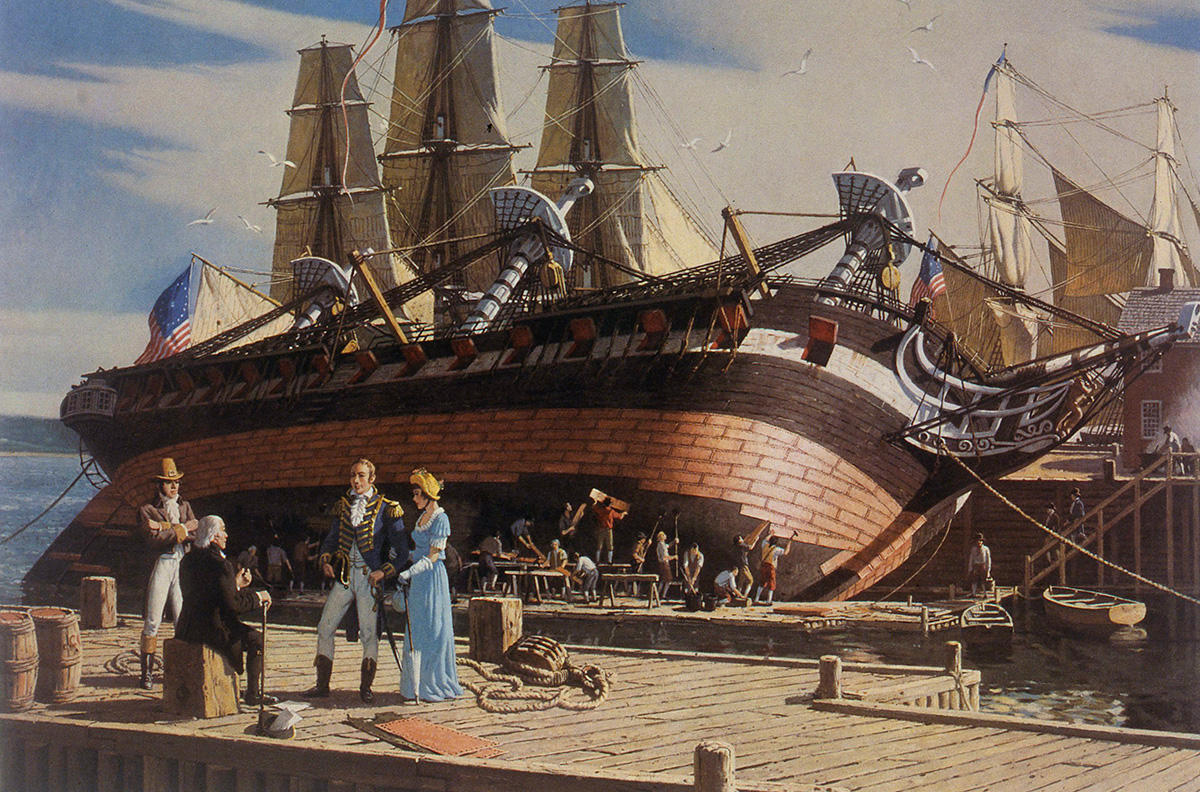Revere’s Foundry & Copper Mill
Though best known for his “midnight” ride and his work in silver and gold, several of Revere’s most significant accomplishments came later in his life. Eager to begin manufacturing other metal products, Revere built a foundry in 1787 on the corner of Lynn and Foster Streets in Boston’s North End. Revere supported the venture with income from his silversmith shop and financial assistance from his Hichborn cousins.
After several years of producing iron products – firebacks and window weights – he began casting bells and cannons, and making bolts and spikes for the shipbuilding industry. Revere taught himself the “secret” of working copper and making it malleable. By 1800, he boasted that “I have made the most improvements in that Branch of Metallurgy of any man in this State, if not in the United States” (Paul Revere to Harrison Gray Otis, March 1800).
Revere also claimed that his copper products were equal in quality to that of his English competitors. The foundry proved to be a forerunner to what would be the most ambitious endeavor of his life, developing a mill for rolling copper. By the late 18th century, sheets of this “valuable & necessary Metal” were urgently needed to sheath the hulls of ships being constructed for the United States Navy. Revere was determined that the new nation should not need to import copper sheet that he himself could make.
In 1800 at the age of 65, Revere, motivated by patriotism and profit, and encouraged by the promise of a loan from the federal government, purchased and renovated a former ironworking mill in Canton, Massachusetts. He became the first American to successfully roll copper into sheets in a commercially viable manner. This venture depended upon his learning a new technology, obtaining scarce raw materials and balancing other variables such as seasonal aspects of water power and the new and somewhat cumbersome federal government.
Driven by an innovative and entrepreneurial spirit, Revere learned by trial and error. “We are gaining experience,” he wrote in 1803, “I…continue to have the whole to feel out, for I have not been able to get any information from any persons. Should I live and be able to take care of the Business for seven years to come I should not get to the Zenith” (Paul Revere to Joshua Humphreys, December 1803). Revere continually refined his operations, making $25,000 worth of improvements to his mill by 1807. For his trouble, he earned the satisfaction of his achievements and the respect of his peers.
This 900 pound bronze bell was cast in 1804 by Paul Revere and Son. It was sold in 1805 to the East Parish Church in Bridgewater, Massachusetts. Today it is on display in the Revere House courtyard. It is one of only 27 bells known to exist which were cast during the period of Revere’s direct involvement at the foundry. Revere cast his first bell in 1792, for his own church, the Second Church of Boston. In 1811 at the age of 76, Revere ended his active partnership in the family firm, passing the day-to-day operations on to his son and grandson. Still he remained an interested participant. Regarding a bell, cast in 1816, that still rings each Sunday in Boston’s King’s Chapel, Revere wrote it is “the sweetest bell we ever made.” Between 1792 and 1843, the Revere foundry cast over 900 bells of all sizes, of which 146 are known to survive.
Paul Revere placed an ad in a Worcester Massachusetts newspaper called the National AEGIS in 1807. It mentions that his foundry, in the North End of Boston, has constantly for sale “Church and Academy Bells, of all sizes, which they will warrant equal to any made in Europe or this country.” Click below to view other unique ads for Revere’s foundry from 1801, 1805, and 1807.
Copper sheeting manufactured at Paul Revere’s copper rolling mill in Canton, Massachusetts was used to cover the dome of the new State House in 1802. These sheets were removed during work on the dome in the 1830s. The Commonwealth chose to cover the dome with 23-carat gold leaf in 1874.
Paul Revere also produced many of the copper, brass, and composition metal fittings for a ship we know today as “Old Ironsides,” USS Constitution. Revere’s copper mill also supplied the copper sheets when USS Constitution was re-coppered for the first time in 1803. Beginning in 1807, the Revere mill began supplying heavy copper sheets used by Robert Fulton of New York City for the boilers in many of his steamboats.
*All quotes are by permission from the Revere Family Papers collection at the Massachusetts Historical Society.


Revere’s Copper Legacy
Revere Copper Products, Inc. traces its history back to the copper rolling mill that Paul Revere established on the banks of the Neponset River in Canton, Massachusetts in 1801.
After Paul Revere died in 1818, his son and business partner Joseph Warren Revere ran the thriving mill until his death in 1868. Family members remained involved well into the 20th century, including John Revere and his sons William Bacon Revere and Edward H.R. Revere.
Over the years a series of mergers and location changes caused the company to change its name several times. With a merger in 1828, the name had become Revere Copper Company. Another merger in 1900 created the Taunton-New Bedford Copper Company, located in New Bedford, Massachusetts. Paul Revere’s original mill property in Canton was sold by 1909. In 1928, the company merged with businesses from four states to create a conglomerate that took the name Revere Copper and Brass, Inc. in 1929. By 1938, the ingenious copper-clad cookware “Revere Ware” (the logo of which included the company’s founding date, 1801) was invented at Revere’s manufacturing division in Rome, NY. At the time of its 150th Anniversary in 1951, Revere Copper and Brass, Inc. was the country’s oldest and largest independent copper fabricator with divisions throughout the country. By 1980, the copper fabricating facilities were reorganized into a new subsidiary – Revere Copper Products, Inc.
Today, Revere Copper Products, Inc. is a smaller employee-owned company, still located in Rome, NY, where it produces a wide range of copper and copper alloy mill materials. The company no longer makes or owns “Revere Ware” (see www.World Kitchen.com). The endurance of Revere Copper Products, Inc. serves as a reminder of the copper work that Paul Revere knew so well, and of the value of the name Revere as an indicator of high quality, reliability, and ingenuity.
Learn more about Revere Copper Products, Inc. at www.RevereCopper.com.


